|
Related FAQs: Fijian Butterflyfishes, Indonesian Butterflyfishes, Butterflyfish Identification, Butterflyfish
Foods/Feeding/Nutrition, Butterflyfish Compatibility, Butterflyfish Behavior, Butterflyfish Systems, Butterflyfish Selection, Butterflyfish Disease,
Over to other Regional
Accounts of Butterflyfishes: Cook
Islands, Hawai'i, Maldives, Red
Sea, Malaysia
/The Fishwatcher's
Guides
Butterflyfishes of Fiji
|
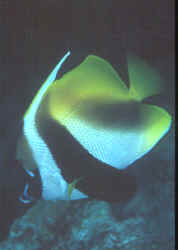
|
| Bob Fenner |
Heniochus monoceros FJ
|
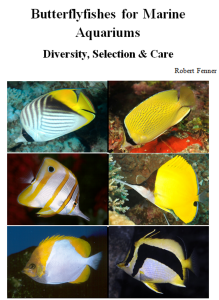 |
Butterflyfishes for Marine
Aquariums
Diversity, Selection & Care
New eBook on Amazon: Available
here
New Print Book on Create Space: Available
here
by Robert (Bob) Fenner |
Bula! Welcome to the warm, clear waters of Fiji, a spread about
cluster of some three hundred islands in the South Pacific. Though most
of the Butterflyfishes (family Chaetodontidae) are on the "too
touchy" side of the pet fish scale of survivability for aquarium
use, the hardier (and medium) species that can be had out of Fiji
should bear attention for two principal reasons: the presence of
professional collecting/holding/shipping businesses in the trade
located here, and secondly, the regular, speedy air-freight service
(direct to Los Angeles).
Everyone who has been in the trade and/or hobby has their
own list of best and least liked organisms, one's that generally
make it and those that don't. Here are my opinions re the
chaetodonts after handling a few tens of thousands over the last thirty
plus years. A couple of explanations. Common and scientific names are
those most often used in the United States; no apology or vain attempt
at completeness is offered. I know there is going to be no absolute
agreement on what I'm putting forth here, but I'll gladly stand
by my assessments; they are borne out of many
individuals being examined from many origins, size ranges, shipping
modalities...
For the purpose of our discussions here, we can place B/F
species (not individuals) as such in distinct "boxes";
"good", "bad", "medium" and
"unknown". "Good Butterflyfishes" I'll define
as those that have been found to have a survival of fifty plus percent
for three plus months (decent specimens shipped properly, passing alive
wholesale through to the "end-user"). "Medium" ones
have maybe 25% survivability; "Bad" B/Fs have less than
twenty percent survival within the same parameters. Yes, the
Butterflyfishes may be demarcated this didactically; the 'good'
ones generally live, the 'bad' ones die easily. To save
download time, click on the genera and FAQs links
"Good" Fijian Butterflies:
| Chaetodon
auriga Forsskal 1775, the Threadfin Butterflyfish. A
great beauty and hardy aquarium specimen, though it will eat coral
polyps and anemones. See other materials on this species by
clicking on name. Widespread Indo-Pacific. An Auriga B/F in
Hawai'i, and a Red Sea one w/o the rear dorsal area
eyespot |
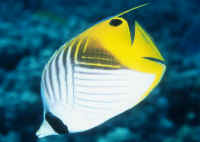 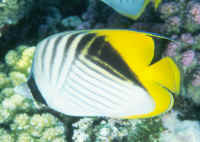
|
|
Chaetodon ephippium Cuvier
1831, the Saddleback Butterflyfish. To a large size (9") and
too often collected too large for aquarium use (get one 3-4"
best). Central and western Pacific. Very nice out of Hawai'i
for use in the U.S. Broad feeder on benthic invertebrates
including coral polyps. Aquarium image.
|
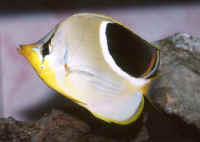
|
|
Chaetodon
lunula (Lacepede 1803), the Raccoon Butterflyfish.
Though not as attractive as its namesake in the Red Sea (C.
fasciatus), the Indo-Pacific Raccoon is just as hardy,
and a very good choice for eating pest Aiptasia anemones in reef
tanks, though it will consume coral polyps in some cases. This
one in the Cook Islands, South Pacific.
|
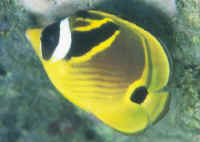
|
|
Chaetodon melannotus
Bloch & Schneider 1801, the Black-Backed Butterflyfish.
To six inches, mainly 3-4. Widespread distribution from
Africa's east coast and Red Sea (pictured here) over to the
mid-Pacific. Hardy, though it does eat soft and hard coral
polyps.
|
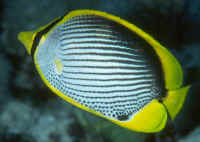
|
|
Chaetodon mertensii Cuvier
1831, the Chevron or Merten's Butterflyfish. A common, but
hardy and good-looking species. You may find the Indian Ocean
variety of this species listed/sold as C.
madagaskariensis... it's the same species. Tropical
central Pacific to east African coast. To five inches long.
Pictured: one in the Maldives, Indian Ocean and one in the
Cooks, South Pacific.
|
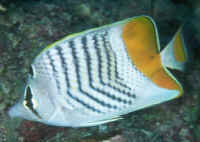 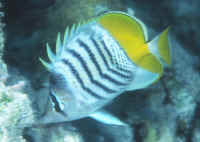 |
|
Chaetodon ulietensis Cuvier 1831, the
Pacific Double Saddleback Butterflyfish. A Pacific version of the
Falcula or Saddleback Butterflyfish (Chaetodon falcula) of
the Indian Ocean. Omnivorous eating habits, chowing down on many
types of invertebrates and algae.. To about six inches in
length.
|
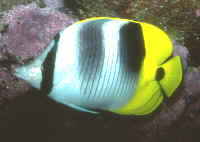
|
|
Forcipiger flavissimus Jordan & McGregor 1898, Yellow
Longnose Butterflyfish, Forcepsfish. Wide variety of foods taken,
rarely corals. Widest species distribution of B/Fs, from east
coast of Africa to west coast of Central America. To eight inches
overall length. Maldives image.
|
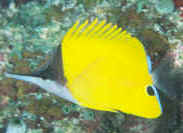
|
| Heniochus acuminatus
(Linnaeus 1758), the Long-Fin Bannerfish.(1) Widespread, central
Pacific to east coast of Africa. Not in Hawai'i. To ten inches
overall length. Cleaners as juveniles. Andaman Sea
image. |
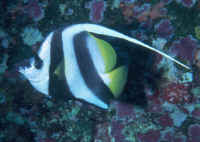
|
| Heniochus chrysostomus
Cuvier 1831, Pennant Butterflyfish.(1) Central to western Pacific
distribution. To six inches long in wild. Similar to H.
varius, which is much more commonly offered in the trade. Heron
Island, Australia image. |
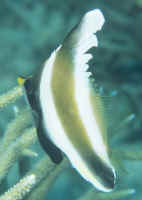
|
| Heniochus monoceros Cuvier
1831, the Masked Bannerfish. To nine inches long, and
"beefy" in profile. Mid-Pacific to east African coast.
Takes all foods with gusto. Maldives image. |
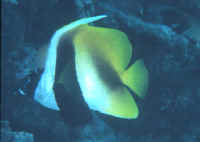
|
|
Parachaetodon
ocellatus (Cuvier 1831), the Eye-Spot Coralfish.
Tropical western Pacific. Generalized feeder. To about six inches
long in the wild.
|
Going back to Sulawesi, with an achin' in my
heart
|
Medium Fijian Butterflies:
| Chaetodon
citrinellus Cuvier 1831, the Speckled Butterflyfish. Aggressive
in the wild, this is another broad feeder of invertebrates,
including corals. Widely distributed and common, though never
plentiful in the mid-Pacific all the way over to Africa. To five
inches overall. One in the Cooks |
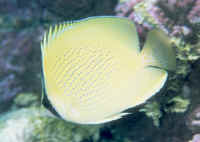
|
"Bad" Fijian Butterflies:
|
Chaetodon baronessa Cuvier
1831, the Eastern Triangular or Baroness Butterflyfish. Like the
similar Indian Ocean congener, Chaetodon triangulum, this
fish is a strict feeder on coral polyps. Too often shipped out of
Fiji, the Philippines and Indonesia. To six inches in the
wild.
|
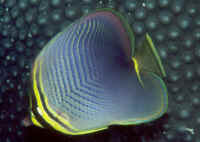
|
|
Chaetodon flavirostris
Gunther 1873, the Black or Yellow-Faced Butterflyfish. Usually
shy and non-feeding. Eats coral polyps, other bottom-dwelling
invertebrates and algae in the wild. To some eight inches long.
Way too often sold to the hobby as juveniles... they don't
live. The first one at a wholesalers, the second in the Cook
Islands.
|
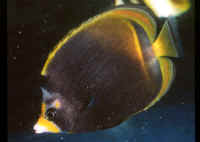 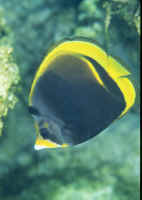
|
|
Chaetodon lineolatus Cuvier
1831, the Lined Butterflyfish. At a foot long, vying for largest
of the family. Widespread from Hawai'i over to the east coast
of Africa, into the Red Sea. A beauty that eats corals, anemones,
much of all else, but doesn't live. One in
Hawai'i.
|
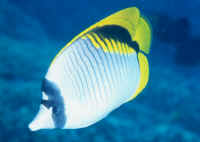
|
| Chaetodon lunulatus Quoy
& Gaimard 1824, the Redfin Butterflyfish. Easily confused with
the Indian Ocean Redfin Butterflyfish, Chaetodon
trifasciatus, this western Pacific to Hawaii congener fares no
better in captivity. To about six inches long in the wild... leave
it there. Here's a specimen in Fiji. |
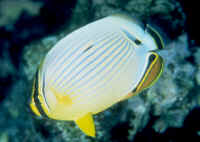
|
| Chaetodon octofasciatus
Bloch 1787, the Eight-banded Butterflyfish. Often sold as a
"misc." butterfly, this is a strict feeder on coral
polyps... rarely lives more than a few days. A juvenile and adult
in Pulau Redang, Malaysia. |
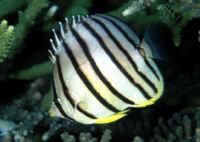 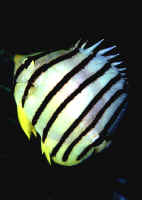
|
|
Chaetodon ornatissimus Cuvier 1831, the
Ornate Butterflyfish. Yet another obligate corallivore. Yes, a
beauty, but does not live in home fish tanks. Indo-west Pacific,
Including Hawaiian Islands. To about seven inches in length.
Commonly offered, doesn't live. This one in Hawai'i.
|
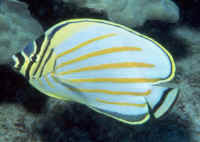
|
| Chaetodon pelewensis
Kner 1868, the Sunset or Dot-Dash Butterflyfish. Very similar to
the hardy Spot-Banded Butterflyfish, Chaetodon
punctatofasciatus but with oblique body barring versus
vertical. Southern Pacific Ocean area. To five inches length
overall. This one in the Cook Islands. |
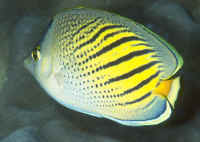
|
|
Chaetodon plebeius Cuvier 1831, the
Blue-Spot Butterflyfish. Maldives eastward to the South Pacific
(Fiji), where these images were made. A beauty that is often sold
in the trade and rarely lives for any period of time to speak of.
This image from Australia.
|
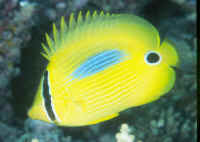
|
|
Chaetodon reticulatus Cuvier 1831, the
Reticulated Butterflyfish. Nice looking, and "friendly"
underwater toward divers, but dismal survival records in
captivity for this coral polyp eater. Found commonly in central
and western Pacific. To six inches total length. One in the
Cooks.
|
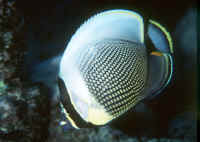
|
|
Chaetodon
trifascialis Quoy & Gaimard 1824,
Chevroned Butterflyfish. This fish is way too often offered in
the trade, belying it's wide distribution, mid-Pacific to the
east coast of Africa and the Red Sea. Almost exclusively lives on
eating Acroporid polyps. To seven inches in length. This one in
the Red Sea.
|
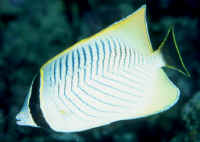
|
| Chaetodon
trifasciatus Park 1797, the Melon or Indian Ocean Redfin
Butterflyfish. Like the same named Redfin Butterflyfish from the
Pacific this is primarily a coral polyp feeder. Note the I.O.
species much bluer dorsal coloration To about six inches long in
the wild. Two Indian Ocean Butterflyfish, the first one in the
Seychelles, the other the Maldives |
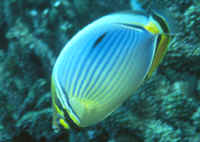 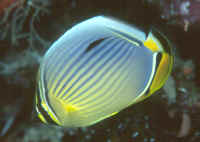
|
| Chaetodon vagabundus
Linnaeus 1758, the Vagabond, Crisscross Butterflyfish. In the wild
feeds on anemones, coral polyps, worms and algae. Compared with the
similar Indian (Ocean) B/F (see above), Chaetodon
decussatus, this species does poorly in captivity. In the
Andaman Sea, and one in Fiji. |
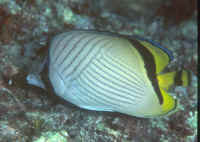 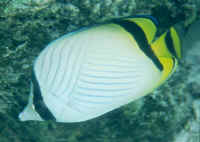
|
Of the "Good" or more hardy historically species of
Butterflyfishes that can be had out of Fiji, most are exemplary
(stipulated they are caught, held correctly, of appropriate size...)
coming out of here to shipping points east and west. Do be on the
look-out, and avoid the ones labeled as "bad" here... they
are exceedingly difficult to keep in captivity.
One note re selection of these two dozen Butterfly species re
timeliness. Akin to children's' tales of porridge being
too hot, cold or just right, you don't want to be too eager
"on arrival" to pick up these and most other Butterflyfish
species from most any collection region. Best to give these fish about
a week post transit to "settle in" (most deaths occur during
this interval), and no more than about two weeks at a dealers (due to
probable copper exposure, trauma, likely starvation).
Cloze:
Don't think the twenty four species of
chaetodonts are the only attraction for pet-fish types in this part of
the South Pacific. There are some seven hundred described species of
marine fishes here, many gorgeous corals (hard, soft, gorgonians)...
all sorts of other invertebrates. Fiji is about twice the time/distance
of flights between Los Angeles and Hawai'i (approximately ten hours
flying time) and a travel bargain. Being on the "other side"
of the planet, Fiji is a great place to visit during our/northern cold
season. Once there, accommodations, food, services are reasonably
priced, the local folks genuine and friendly, the water warm and clear.
See you there.
Bibliography/Further
Reading:
 |
Butterflyfishes for Marine
Aquariums
Diversity, Selection & Care
New eBook on Amazon: Available
here
New Print Book on Create Space: Available
here
by Robert (Bob) Fenner |
Allen, G.R., 1979. Butterfly and Angelfishes of the
World, Vol. 2. Wiley & Sons, N.Y.
Allen, Gerald R., Roger Steene & Mark Allen. 1998. A
Guide to Angelfishes & Butterflyfishes. Tropical Fish
Research/Odyssey Publishing. 250pp.
Burgess, Warren, 1978. Butterflyfishes of the World.
T.F.H. Publications, Neptune City, N.J. 832 pg.
Burgess, W.E., H.R. Axelrod & R.E. Hunziker III,
1990. Atlas of Aquarium Fishes, Vol 1. Marine Fishes. T.F.H.
Publications, Jersey.
Campbell, Douglas, 1980. marines: Their Care &
Keeping. Butterflyfishes, Pt. 1, 2. FAMA 10,11/80.
Chlupaty, Peter, 1978. Keeping Butterflyfishes. T.F.H.
4/78.
Emmens, Cliff W., 1985. Keeping Chaetodons. T.F.H.
5/85.
Fenner, Bob, 1990. Bannerfish butterflies, the genus
Heniochus. FAMA 6/90.
Fenner, Robert. 1995. The Yellow Long-Nose
Butterflyfishes. TFH 11/95.
Fenner, Robert. 1995. The Pacific Double-Saddle
Butterflyfish, Chaetodon ulietensis. TFH 12/95.
Fenner, Robert. 1996. Butterflyfishes you don't want.
TFH 6/96.
Fenner, Robert. 1997. Rating the Butterflyfishes of the
Red Sea. TFH 3/97.
Fenner, Bob. 2001. Butterflyfishes of the Maldives,
Indian Ocean. FAMA 6/01.
Hunziker, Ray, 1992. The ten best Butterflyfishes. T.F.H.
6/92.
Michael, Scott, 1994. Bad Butterflyfishes. A.F.M.
7/94.
Michael, Scott W. 1998. Butterflyfishes: The secret is to
choose the right species, Recommendations for your aquarium. AFM
2,3/98.
Moenich, David R. 1991. The Butterflyfishes. Aquarium
Fish Magazine 1/91.
Nelson, Joseph S., 1994. Fishes of the World, 3rd ed.
Wiley & Sons, N.Y.
Refano, Joe, 1983. The importer speaks: the
butterflyfishes pt. I, II. T.F.H. 10,11/83.
Siegel, Terry, 1973. Butterflies. Marine Aquarist
4(2):73.
Steene, Roger C., 1985. Butterfly & Angelfishes of
the World, Vol. 1 Australia. Mergus Publ., Germany
Taylor, Edward C.
2000. Marine Angels and Butterflies. TFH 2-8/00.

